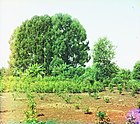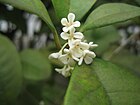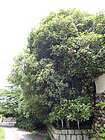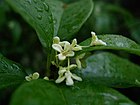Note: This is a project under development. The articles on this wiki are just being initiated and broadly incomplete. You can Help creating new pages.
Osmanthus fragrans - Fragrant olive
Fragrant olive is a species native to Asia from the Himalayas through southern China to Taiwan and southern Japan and southeast Asia as far south as Cambodia and Thailand.
Uses
Parts Used
Chemical Composition
The content of 1,3,5-Trioxepane was the highest in Latifolius group, accounting for 22.69 %. Ketones, alcohols, asters, aldehydes and acids were the major constituents of four different O. fragrans, representing 90.05 %, 95.07 %, 86.76 %and 80.21 % of the essential oil, respectively[1]
Common names
| Language | Common name |
|---|---|
| Kannada | |
| Hindi | silang |
| Malayalam | |
| Tamil | |
| Telugu | |
| Marathi | NA |
| Gujarathi | NA |
| Punjabi | NA |
| Kashmiri | NA |
| Sanskrit | Brihat bakula, Vasuka |
| English | Fragrant Olive, Sweet osmanthus |
Properties
Reference: Dravya - Substance, Rasa - Taste, Guna - Qualities, Veerya - Potency, Vipaka - Post-digesion effect, Karma - Pharmacological activity, Prabhava - Therepeutics.
Dravya
Rasa
Tikta (Bitter), Kashaya (Astringent)
Guna
Laghu (Light), Ruksha (Dry), Tikshna (Sharp)
Veerya
Ushna (Hot)
Vipaka
Katu (Pungent)
Karma
Kapha, Vata
Prabhava
Habit
Identification
Leaf
| Kind | Shape | Feature |
|---|---|---|
| Simple | Opposite | leaves are leathery, lustrous, dark green leaves 2-5 in. long; finely dentate or entire |
Flower
| Type | Size | Color and composition | Stamen | More information |
|---|---|---|---|---|
| Unisexual | 2-4cm long | White | 5-20 | Very fragrant, small white flowers in fall and some flowers in early spring |
Fruit
| Type | Size | Mass | Appearance | Seeds | More information |
|---|---|---|---|---|---|
| Drupe | 1.5-3 | Fruit coulor is purple | many | {{{6}}} |
Other features
List of Ayurvedic medicine in which the herb is used
- Vishatinduka Taila as root juice extract
Where to get the saplings
Mode of Propagation
How to plant/cultivate
Easily grown in any well-drained soil in sun or part shade[11, 200], but flowering more freely in a sunny position[3]
Commonly seen growing in areas
Photo Gallery
References
External Links
- Ayurvedic Herbs known to be helpful to treat Carbuncles
- Ayurvedic Herbs known to be helpful to treat Boils
- Ayurvedic Herbs known to be helpful to treat Whoping cough
- Ayurvedic Herbs known to be helpful to treat Retinitis pigmentosa
- Ayurvedic Herbs known to be helpful to treat Dysmenorrhoea
- Ayurvedic Herbs known to be helpful to treat Rheumatism
- Ayurvedic Herbs known to be helpful to treat Bruises
- Herbs with Fruits used in medicine
- Herbs with common name in Hindi
- Herbs with common name in Sanskrit
- Herbs with common name in English
- Habit - Evergreen shrub
- Index of Plants which can be propagated by Seeds
- Index of Plants which can be propagated by Cuttings
- Herbs that are commonly seen in the region of Mountain areas
- Herbs that are commonly seen in the region of Himalayas
- Herbs that are commonly seen in the region of Forests
- Herbs
- Ayurvedic herbs that don't have flower, fruit and leaf photos
- Ayurvedic herbs that don't have seed photos
- Oleaceae









